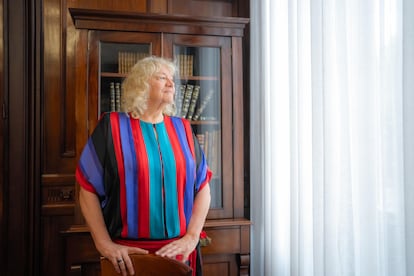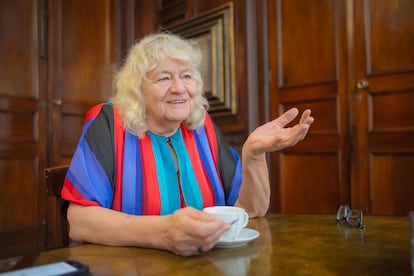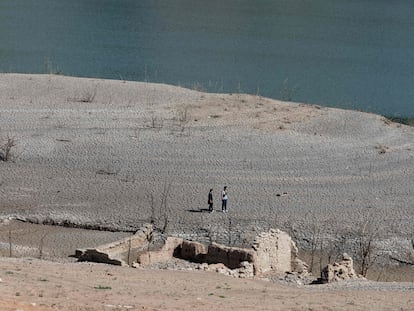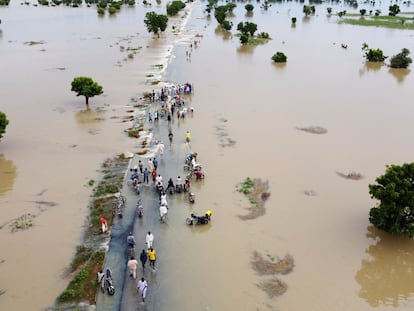Ellen Thomas, paleoclimatologist: ‘It’s not the Earth that needs to worry, it’s humans’
The scientist, winner of the BBVA Foundation Frontiers of Knowledge Award for her contributions to the discovery of a greenhouse effect 56 million years ago, warns of the risks of the current rate of global warming


Science is full of serendipity. Coincidences, valuable findings that are made by chance. From Archimedes, who is said to have discovered his famous principle when soaking in the bathtub, to Viagra, which was the result of a failed experiment that set out to find potential cardiovascular effects in sildenafil. Paleoclimatologist Ellen Thomas also had something like this happen to her on one of her scientific expeditions to Antarctica in the 1980s, while studying sediment samples in search of benthic foraminifera, microscopic organisms that live on the seafloor. “We are in a warming period, and we were actively trying to look for a cooling of the Antarctic continent, not a warming episode. It’s something we came across by chance,” she admits.
If the sediments deposited on the seafloor are a kind of chronological history book, the deepest layers are the oldest. In the one corresponding to the Paleocene and Eocene, more than 50 million years ago, Thomas found, against all odds, substantial changes in microorganisms. There had been an unexpected mass extinction and an intense global warming associated with this phenomenon. Together with studies by scientist James Zachos, the paleoclimatologist described an anomalous episode in the planet’s history: a kind of greenhouse effect 56 million years ago in which massive CO₂ emissions occurred and the global temperature rose by five to six degrees. This phenomenon still serves today as a reference for the scientific community to predict the destructive impacts of current global warming.
Thomas, who is a researcher in Earth and Planetary Sciences at Yale University and Professor Emeritus of Integrated Sciences at Wesleyan University, has been awarded the BBVA Foundation Frontiers of Knowledge Award in Climate Change “for the transcendental contribution” “to the discovery of an important natural event in the fossil record” together with Zachos. This is, the jury noted, “a powerful analogy” of the current climate change. The paleoclimatologist spoke to EL PAÍS in Bilbao, whe she received the award.
Question: What does it feel like when you make an unexpected find?
Answer: It is not a single moment at all. Authors like Isaac Asimov, who wrote science fiction, said that the important thing in science is not the Eureka! moment, but to say, “How strange,” because there is something you don’t understand, and it takes you some time to understand what it means.
I study microscopic organisms that live in the deep ocean, which is the largest ecosystem on the planet, since there is more sea than land and most of the sea is deep ocean. Most of the world’s habitats are in the deep sea and if you see something happening in the deep sea, it means it’s global. I thought that the organisms I studied would never show a major extinction event because there are known types of extinctions on Earth, for example the dinosaurs, and in that period the organisms I study did not go extinct. I thought that in the deep ocean they would always have a place to live. And then I was on this mission where we were drilling and what I found — that I didn’t expect — was that between two samples there was a big difference in terms of the organisms that I was studying: they had different shapes, they were different species. This difference meant that there was a great extinction and I could not explain it.
Q. How is this extinction related to climate change?
A. That’s where my work with the other award winner [James Zachos] begins. My organisms make shells, like snails. The shells are made of calcium carbonate and by analyzing it chemically, we get all kinds of information about the environment in which the shell was formed. It tells us the temperature at which that shell was formed, and what we saw is that some species had gone from colder to warmer, a difference of five to eight degrees Celsius. In addition, calcium carbonate contains calcium, carbon and oxygen: the oxygen tells you what the temperature is and the carbon tells you that at the time the temperature was rising there were greenhouse gases being emitted into the atmosphere. And we deduce that this warming is due to greenhouse gases. At that time of warming and greenhouse gas emissions, millions of years ago, there was also an acidification of the oceans.

Q. What does something that happened 56 million years ago have to do with what is happening now?
A. We are also emitting greenhouse gases and the planet is getting warmer. What is interesting, if a bit depressing, is that so far we are trying to predict the future, but we have seen climate predictions of 20, 30 or 40 years, although there is a much, much longer history behind it. By analyzing history, we can see an example of global warming and what effects it has on ecosystems: they do not do well where it is warmer and migrate northward. Plants do not move, but may die where they are and start to grow further north.
Q. What is our past telling us about our future? Can such a mass extinction be repeated?
A. The problem we have here is the pace at which things happen; how fast things happen. Humans are emitting greenhouse gases faster than they were produced 56 million years ago. If we make these emissions faster, we have more environmental problems. Because you can say that the Earth has suffered episodes of warming in the past and not to worry, however, it is not the Earth that has to worry, it is humans. As I said before about the migration of plants: we have agriculture, in Spain there are specific crops, but if the climate warms up, we will no longer be able to grow them. Maybe they can be grown in the Netherlands, but not in Spain anymore. We have a huge adaptation ahead of us because our farmers grow crops in specific soils, but if the climate is not suitable, there will be a problem.
We are emitting greenhouse gases at a rate that will overload the system.
Q. What happened 56 million years ago has been associated with volcanic activity and the current global warming is due to human action. Are we more devastating than nature itself?
A. In the global warming episode 56 million years ago, the emission of these greenhouse gases occurred over 1,500 years (according to the best estimates), and the effects on the world were not as devastating as those of 66 million years ago, which were immediate. The asteroid impact that killed the dinosaurs 10 million years earlier was instantaneous, and the effects of this rapid process were devastating to life on Earth. Humans have been emitting greenhouse gases since the Industrial Revolution, just a few hundred years ago. Some of us argue that what counts is the rate at which we emit: we are emitting greenhouse gases at a rate that is somewhere between an asteroid impact and several thousand years, and the effects are going to be somewhere in the middle of the two.
The world has seen these greenhouse gas emissions on several occasions and has been able to reduce them, but they were much slower. What is important is the speed at which we are emitting things: if we emit greenhouse gases too fast we are going to overload the system, and nature is not going to be able to capture that CO₂.
Q. You have said that the danger is for human beings, not for the planet.
A. Yes, the danger is for human beings. We cannot save the planet. The planet has been surviving for millions of years, it does not care if the entire surface of the Earth or the oceans are destroyed. The problem is for us. In the Netherlands we don’t like the idea of sea level rising by 20 meters. It’s our infrastructure: I live in Connecticut, and we have a historical record of the sea level going up and down, the marshes coming in and going out, but now we have big cities, roads, etc., in the area. If the sea comes back in, there’s going to be a problem — not for the sea, which has already moved in and out of the land many times, but for us, who have roads, railroads, sewage, and so on. The problem is going to be for us.
Q. If what happened 56 million years ago serves as an analogy to the current situation, where are we now in that phenomenon?
A. It is not so easy because it is an analogy, it is not exact. To begin with, 56 million years ago, the climate was already warmer than it is now. There were no ice caps at the poles, for example. One of the most difficult things in science is trying to figure out time on the human time scale, so there is a lot of debate about whether this period of warming in the past occurred over 2,000 or 10,000 years. However, it is clear that the most comprehensive thing is to compare the temperature increase: we are now at a level of global warming of one and a half degrees, we are between a quarter and a third of the global warming we saw in that period.
I don’t think these technological fixes are going to help us in the future: we’re going to have to start adapting.
Q. Can we really do anything to stop this process?
A. That is not my field of study. Despite the agreements we have reached, despite the pandemic, which made us stop, CO₂ has continued to rise. That is not a scientific question. It is a question that has to be asked of people, of humanity, because it has to do with the way people react to processes. From the scientific point of view, we already know what this is all about; but what we do about it is no longer my job. It is disheartening that we do not stop burning fossil fuels, but this is a societal decision and society does not [want to] take that step.
Q. Are you very pessimistic?
A. I am more pessimistic than the other award winner, who is more optimistic and believes that technological changes may help. But I don’t think these technological fixes are going to help us in the future. Not only do we have to try to stop [using fossil fuels], but we have to try to adapt. Now we are talking about resilience, about how to deal with these consequences. I think that, as a society, we are going to have to start adapting to this warming.
Q. Is there a point of no return?
A. We do not know. There may be. This is very interesting from a scientific point of view, but it is very depressing from a social point of view. We may have a turning point. There may come a time (and it may not be too far away) when we start a process that we can no longer stop. I think there are two processes that we will not be able to stop: the Antarctic ice shelf is below sea level, so if the water warms up so much that it destabilizes this shelf, it will fall apart in a short time, end up floating and reach lower latitudes and this could mean a sea level rise of 11 meters. Another potential tipping point is that the permafrost, the frozen soil of the Arctic, has several layers with a lot of organic life, and they have started to thaw, and the peat will be decomposing with this reaction [the release of greenhouse gases].
Sign up for our weekly newsletter to get more English-language news coverage from EL PAÍS USA Edition
Tu suscripción se está usando en otro dispositivo
¿Quieres añadir otro usuario a tu suscripción?
Si continúas leyendo en este dispositivo, no se podrá leer en el otro.
FlechaTu suscripción se está usando en otro dispositivo y solo puedes acceder a EL PAÍS desde un dispositivo a la vez.
Si quieres compartir tu cuenta, cambia tu suscripción a la modalidad Premium, así podrás añadir otro usuario. Cada uno accederá con su propia cuenta de email, lo que os permitirá personalizar vuestra experiencia en EL PAÍS.
¿Tienes una suscripción de empresa? Accede aquí para contratar más cuentas.
En el caso de no saber quién está usando tu cuenta, te recomendamos cambiar tu contraseña aquí.
Si decides continuar compartiendo tu cuenta, este mensaje se mostrará en tu dispositivo y en el de la otra persona que está usando tu cuenta de forma indefinida, afectando a tu experiencia de lectura. Puedes consultar aquí los términos y condiciones de la suscripción digital.
More information
Últimas noticias
Most viewed
- Alain Aspect, Nobel laureate in physics: ‘Einstein was so smart that he would have had to recognize quantum entanglement’
- Mexico’s missing people crisis casts a shadow over World Cup venue
- Why oil has been at the center of Venezuela-US conflicts for decades
- Trump clarifies who is ultimately in charge in Venezuela: ‘Me’
- Mexico seeks to shore up its defenses following US incursion in Venezuela










































